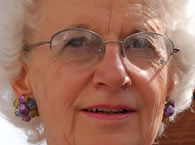News Release: Emory Healthcare, Research, School of Medicine
Dec. 10, 2008
Clinical Trial for Macular Degeneration Seeks a New Way of Seeing

The brain's remarkable ability to reorganize itself to compensate for vision loss, the ability called plasticity, may be the key in helping those with age-related macular degeneration (AMD) see better. This theory is the impetus behind a study between Emory Eye Center and the Georgia Institute of Technology (Psychology). Patients who have retinal damage because of AMD sometimes begin to see by using other parts of the intact retina. By "training" these patients to focus on using those good retinal cells, they may experience increased visual acuity.
Susan Primo, OD, MPH, of Emory Eye Center, says the Phase 2 portion of the clinical trial "Age-Related Macular Degeneration and Cortical Reorganization" will help bridge the knowledge gap between cortical plasticity and visual function.
"Results from these studies will begin to provide answers for how behavioral improvements in AMD patients can lead to changes in underlying brain activity and, most importantly, how we can influence those changes to maximize use of remaining vision," Primo says. "Once this link is made, clinicians and healthcare engineers can use the information to design and implement rehabilitation therapies and technologies that will expedite efficient use of fixation strategies ultimately fostering cortical reorganization."
Age-related macular degeneration is the leading cause of blindness in the elderly, accounting for 10 million people who have reduced vision in the United States (Research to Prevent Blindness). AMD is a disease associated with aging that gradually destroys sharp, central vision. Central vision is needed for seeing objects clearly and for common daily tasks such as reading and driving. People in middle-age have about a 2 percent risk of getting AMD, but this risk increases to nearly 30 percent in those over age 75. More than 200,000 develop AMD each year in this country.
"Visual rehabilitation is entering an exciting area of research that expands our current understanding of neuroplasticity of the visual system," says Timothy W. Olsen, director of Emory Eye Center and a retina specialist. "Findings from this study and others may help us understand the tremendous capacity of our central nervous system, especially as it relates to sensory deficits. Combining expertise of the Emory Eye Center with Georgia Tech opens exciting new opportunities in vision research."
Phase 1 of the study appears in the December edition of the journal Restorative Neurology and Neuroscience (Restor Neurol Neurosci. 2008;26(4-5):391-402.)
Phase 1 of the trial at Emory involved seven patients, and the Phase 2 portion at Emory will have 10 patients. The goal will be to study hundreds of patients in the near future. Results will be disseminated in late 2009.
Funding is provided through the Health Systems Institute Seed Grant, a collaboration between Georgia Institute of Technology and Emory University/Children's Healthcare of Atlanta/Egleston. The HSI Seed Grant supports collaborative and interdisciplinary research projects that will help stimulate innovative healthcare research and promote improvements in healthcare. The seed grant awards are specifically designed to provide funding for novel projects that demonstrate a high potential for enhanced diagnostic capabilities of diseases, lead to new inventions that yield new patents, licenses and/or commercial products, lead to high quality peer-reviewed publications and those with high potential to leverage seed funding into extra-mural support.
###
About Emory Eye Center: The Department of Ophthalmology and Emory Eye Center have a mission to conduct pioneering research into blinding eye diseases, to educate and train eye professionals, and to provide excellent patient care. The Department includes 35 ophthalmologists, seven optometrists, nine basic scientists, 11 post-doctoral fellows, and nine researchers in other Emory departments who hold joint appointments in the Department of Ophthalmology. Ophthalmology research is supported by $6 million in NIH funding. The Department remains in the top rankings (#9 -- 2008) by U.S. News & World Report for the 12 years the magazine has held a ranking for Ophthalmology. It also ranks in the Top Ten in all four categories surveyed by Ophthalmology Times annual report.
###
The Robert W. Woodruff Health Sciences Center of Emory University is an academic health science and service center focused on missions of teaching, research, health care and public service. Its components include schools of medicine, nursing, and public health; Yerkes National Primate Research Center; the Emory Winship Cancer Institute; and Emory Healthcare, the largest, most comprehensive health system in Georgia. The Woodruff Health Sciences Center has a $2.3 billion budget, 17,000 employees, 2,300 full-time and 1,900 affiliated faculty, 4,300 students and trainees, and a $4.9 billion economic impact on metro Atlanta.
Learn more about Emory’s health sciences:
Blog: http://emoryhealthblog.com
Twitter: @emoryhealthsci
Web: http://emoryhealthsciences.org
